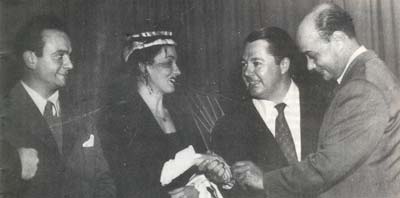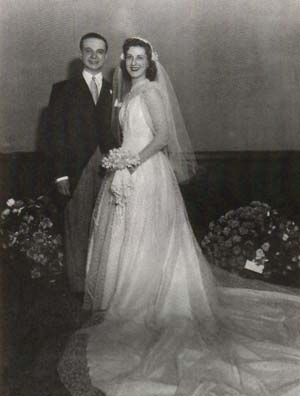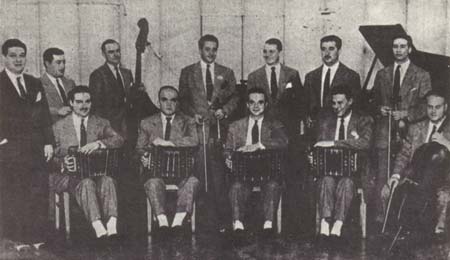By
Piazzolla - Astor Piazzolla, from New York to Mar del Plata

returned to Argentina when I was 15 or 16 years old. I don’t remember well. Straight to Mar del Plata. And there I soon heard the Elvino Vardaro’s Sextet. I was stabbed through the liver for the first time. I want to do this. I said to myself.
«Later I heard Aníbal Troilo and I was sort of crazy. The same happened to me as for other orchestras like the one led by Pedro Laurenz and the one by Pedro Maffia. The styles of Francisco Canaro and Juan D'Arienzo were never of any interest to me.

«In 1937 the Miguel Caló’s orchestra came to town to play at the Porta tearoom, in the fishermen’s quay, near the Bristol seashore. I used to run away in the evening to listen to it. I went mad again. I reached the musicians and I asked Julio Ahumada, Argentino Galván and the others how Pichuco was like, the way he placed his hands. I was quite sticky, I wanted to know everything. By that time I was delirious, I used to play Gershwin’s “Rhapsody in Blue” without adaptation, just like it was written. I pressed so much that finally they listened to me. Ahumada asked me if I was nuts. When Caló heard me he encouraged me to travel to Buenos Aires that he would give a job.
«Dad gave me 200 pesos. When they were spent I had to come back. A friend of Daddy’s brought me. I went to live in a boarding house on 1492 Sarmiento Street, third floor. Everyday I went to the Café Germinal to listen to Troilo. I learned his repertoire by heart.
«One day Juan Miguel Rodríguez, aka “Toto”, was ill. Hugo Baralis, the one who was my first friend told “Fats” (Gordo) that he should hear me. Troilo answered: “No, he’s a kid, he won’t be able to play this”. “But I can”, I replied. Baralis insisted. And so did I. “Let me do it, Pichuco, come on”, I said. Then he asked me if I knew how to read music. “But I know all by heart”, then he said yes.
«When I made my debut at the Germinal I played everything by heart and Orlando Goñi, with his everlasting joking way, began to look at me out of the corner of his eye. “What! Are you an American?”, he had heard playing Rhapsody in Blue. “Why those strange chords?”. They started to look at me as if I were a bug. After the job I arrived home and devoted myself to study music because I had quit high school. I wrote my father a letter about the news and he came to Buenos Aires on a motorcycle with his brother-in-law. Troilo had already hired me.
«The day after Dad came we went to have lunch at Troilo’s place on 3280 Soler Street. His mother cooked, it was marvelous. Finally, my old man told Pichuco: “Mister Troilo, the only thing I’m going to ask is that you take care of my son. He’s only 17 and I don’t like that he works by night at his age. So it depends on you, you know, cabarets, women”. El Gordo (Fats) replied: “Don Vicente, don’t worry, I’m going to take care of the kid”. When they left on the motorcycle I told him: “¡Che Gordo!, Are we going tonight to the “Doble tres” of Avellaneda to gamble?”. “You’re right, Gato (Cat)” —he then called me that way—, and that was my beginning under Troilo’s care.
 «I missed my parents very much. At that boarding house I wept when I thought of them, I was very lonely. Because of that one day I told Baralis that I would like to have a girlfriend and marry her. It was Hugo who introduced me to Dedé, in his own place on a 21st day of September. I was not used to going out with ladies of the night, cabaret women. I pitied them and my Dad’s warnings haunted me. I was 19 and she was 17. It was 1940. One year later we were married. She studied painting and I had an obsession with music. I was crazy for Stravinsky when a girl gave me “The Rite of Spring” and I said to myself: “Who’s this crazy guy?”. In every case, Baralis was an open ear for me. I used to tell him everything.
«I missed my parents very much. At that boarding house I wept when I thought of them, I was very lonely. Because of that one day I told Baralis that I would like to have a girlfriend and marry her. It was Hugo who introduced me to Dedé, in his own place on a 21st day of September. I was not used to going out with ladies of the night, cabaret women. I pitied them and my Dad’s warnings haunted me. I was 19 and she was 17. It was 1940. One year later we were married. She studied painting and I had an obsession with music. I was crazy for Stravinsky when a girl gave me “The Rite of Spring” and I said to myself: “Who’s this crazy guy?”. In every case, Baralis was an open ear for me. I used to tell him everything.
«By that time Rubinstein came to play at the Colón. I had written a prelude for piano when I was Dedé’s fiancé and I rushed to his house. As a matter of fact, he lived in a mansion owned by the Alzaga Unzué family on Arroyo Street. I was unembarrassed. When he read what I had brought for him he told me: “You have to study! Do you want to study?”. “Of course”, I answered. “Very well, I will recommend you Juan José Castro”. He phoned him but as the latter was unable he mentioned to me Alberto Ginastera and so I was his student twice a week at eight o’clock in the morning. I went to bed at five because I was still playing with Troilo. I scarcely slept. So four or five years passed and I studied everything.
«I began to write charts for Troilo. The first one was “Azabache”. The arranger was Galván but he had too much work and he had no time for everything. That arrangement was recorded by Pichuco. The second one was “Inspiración”. The arrangement of “Azabache” was a boom. I used the violins playing scales high, a thing “El Gordo” had never done before. “Don’t you go too far!” he used to tell me and made corrections. He did not want many subtleties so that people would dance. There were from twenty to thirty balls a month. We lived on that and a little chac chac chac was always expected. One day I got tired of that and I left. It was 1944.
«The musicians that played with me were zero, musically speaking and, furthermore, they were destructive guys. They stained or tore the homework I had to show Ginastera.
«I discovered Béla Bartók and began to do my best not to miss the rehearsals of the National Symphony Orchestra in the Gran Rex theater. Once again I was sticky with the musicians by asking them all I thought was interesting. I went on with tango, I led the Francisco Fiorentino’s orchestra. We played at the “El Marabú”. I wrote a quite beautiful arrangement of the Mores’s tango “Copas, amigos y besos”. I wrote the introduction with a cello solo. It was a crazy thing. The women that worked there when they heard it they danced imitating classical dancers. They pulled my leg. So I suppressed the introduction. Fiore didn’t like it either. I got tired again, it was 1946 and I quit. I put together my own orchestra.

«I was always asked about the melodic aspects, never about the rhythmical aspects, but when I discover Astor Piazzolla, I mean myself, was when I was arranger for Troilo and for Basso and I composed “Para lucirse”. There I discovered that the melodic elements had, in a second section, a rhythmic background and so I started to enjoy the swing of tango and it is then when I delve into jazz. Art Tatum, Stan Kenton, Miller, Peterson, I mixed them with the classics and so daring harmonies came out. I composed “Para lucirse” in 1951 and it amazed me but I only wrote one number a year. In 1952 “Prepárense” and later “Lo que vendrá”. But I still was not a creator, just an arranger.
«In 1954, in Paris, I was very happy, a true musical genius and then I showed my music to Nadia Boulanger. She looked at it for a while and then she told me: “This is a music very well written but here where is Piazzolla?” At that moment was the end of the genius. She asked me what I was devoted to, what other kind of music I made. With a great effort I finally told her that I played bandoneon and composed tangos. She asked me to play one of mine on the piano, an instrument which I didn’t mastere. I played “Triunfal” which I had written a little time before. And then she told me: “There is Piazzolla, never leave it!”.
«The words of the old teacher did not humiliate me. I had been cheating myself. “What a genius, what a wonder is this guy writing symphony music¡”, so they said. Even the famous critic Jorge D’Urbano praised one of my works, a symphonieta. My dream was to become a pianist and playing and conducting a concerto for piano and orchestra.
«I’m identified with Gershwin. Without straying away from popular music he composed preludes, “Rhapsody in Blue”, “Concerto in F”, “Porgy and Bess”. The Argentine music has no national identity. In tango there were no experiences of something different like what Gershwin did. Yes, there were some attempts by the so-called academic composers but they were disastrous. It was not tango, nor even music.
«I think that tango is more important than folk music. There are quite a few that may be called avant-garde musicians, or there is no one, nobody. An intuitive man like Atahualpa Yupanqui is the one who stands out most but he is not an avant-gardist, but his music is authentic. “Cuchi” Leguizamón writes quite beautiful pieces, I like them, but they are not avant-garde. Waldo de los Ríos like Manolo Juárez —that is a great musician—, may have made a great change in folk music. I think Juárez is more a musician than a folklorist.
«In tango there are many people with capabilities but they are unable to do what they like because they have to eat every day. Eduardo Rovira had to stop his experiences due to his financial situation, because of his lack of job. It’s very hard. We always have to have someone beside us, someone who encourages us. I had Dedé, my first wife. If we were able to eat, we ate, otherwise we didn’t. But we went to France to study and I was so lucky that my parents kept our two children in Buenos Aires, fed them and even sent us money.
Note published in “La Opinión Cultural”, from an interview by Carlos Rodari and written down by Julio Ardiles Gray and Blas Matamoro. Published on May 30, 1976.